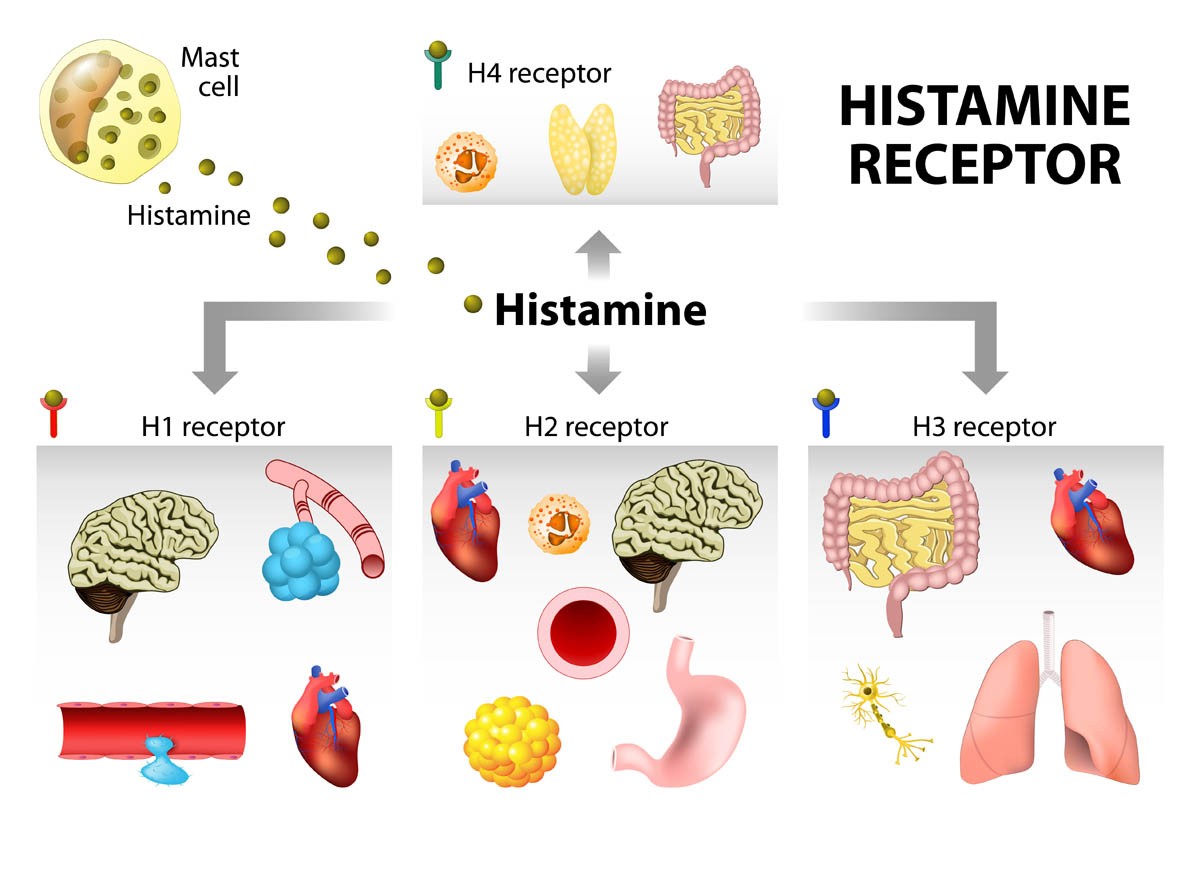What are antihistamines?
Antihistamines are a class of drugs that block the effects of histamine, a chemical produced by the mast cells and basophils in response to a real (bacteria/virus/fungus) or perceived (allergen such as dust) invasion.
Histamine binds to receptors (docking stations) on specific cells, which trigger several responses such as dilation of the blood vessels, which causes fluid to leak into nearby tissue (runny nose, watery eyes for example) as well as inducing itchiness and smooth muscle contraction, which can lead to breathing difficulty due to bronchodilation.
Antihistamines work by competing with histamine to bind to the receptors on the cells. Interestingly, allergies in humans more commonly produce sneezing, runny nose, and watery eyes whereas cats more commonly develop skin disorders such as itching and rashes.
Antihistamines may be first-generation or second generation. First-generation often cause drowsiness, whereas second-generation don’t. Second-generation are less likely to cause drowsiness, are longer-acting but more expensive to purchase.

Types of allergy
- Insect – The most common type of allergies in cats are insect bites or stings, predominantly fleas. However, any biting or stinging insect has the potential to cause allergic reactions in cats.
- Inhalant – The second most common type of allergy to affect cats. Responsible allergens include pollens, cat litter, smoke, dust mites, and moulds.
- Food – The most common food allergies in cats are to beef, fish, chicken, eggs, and wheat. Storage mites are also a potential cause of food allergies in cats.
- Contact – The least common of the four groups of allergies to affect cats. This may be due to contact with an irritant (such as a chemical) or with an allergen including plants, cat litter, topical medications, shampoos etc
Symptoms
This can vary depending on the underlying cause, but it is common for allergies in cats to affect the skin. Depending on the cause, symptoms may be seasonal or non-seasonal. Common symptoms may include:
- Itching and scratching
- Urticaria (rash)
- Crusty lesions on the back, close to the base of the tail (miliary dermatitis)
- Overgrooming
- Hair loss
- Vomiting and/or diarrhea (with food allergies)
Diagnosis
This may depend on the type of allergy your veterinarian thinks your cat may have, common diagnostics include food trials and intradermal allergy testing.
- Food trials: If your veterinarian suspects your cat has a food allergy, a food trial will be carried out. The cat is switched to a novel protein (such as duck, or lamb) to see if symptoms improve. If they do, your cat will then be put back on his regular diet to see if symptoms return.
- Intradermal testing: Also known as scratch testing, the intradermal test can be used for other types of allergy to determine the allergen. An area of skin on the belly is shaved, several allergens are then injected into the skin. If your cat has an allergy to a specific allergen, small red hives will appear.
Dosage
Note: Some doses state per kg, and some state per cat.

Source: Plumb’s Veterinary Drug Handbook – 9th Edition.
Antihistamine trials
Your veterinarian may recommend a trial, to determine the most effective antihistamine for your cat. Initially, your cat may need cortisone and antihistamines; once symptoms improve, cortisone will be withdrawn. Antihistamines don’t cure allergies; however, the side effects are less severe than those of cortisone. Not all antihistamines will work with your cat or will produce undesirable side effects, so a trial will help to determine the best type for your cat.
An antihistamine is administered to your cat for ten days, and his response is monitored. If there is no improvement, he moves on to the next time of antihistamine until a suitable one is found.
Other ways to reduce allergies in cats
Steroids are an effective drug to control pruritis and relieve symptoms. Injectable steroids will be used initially; these can last between 2-6 months. After that, your cat may be given oral steroids. Long-term use of steroids carry side effects, so your cat will either be weaned off if possible or kept on the lowest dose possible. Use a reliable flea control programme too.
Omega-3 fatty acids are essential fatty acids (EFA’s) which cats must consume as they are unable to synthesise them. There are several omega-3 fatty acids, including ?-linolenic acid (ALA), docosahexaenoic acid (DHA) and eicosapentaenoic acid (EPA). Fatty acids can reduce inflammation and the effects of histamine in cats with allergies. Not all cats will respond to omega-3 fatty acids, but they can be of help, especially when used with antihistamines. Anti-itch shampoos and rinses to help relieve itching. Look for products containing oatmeal.

